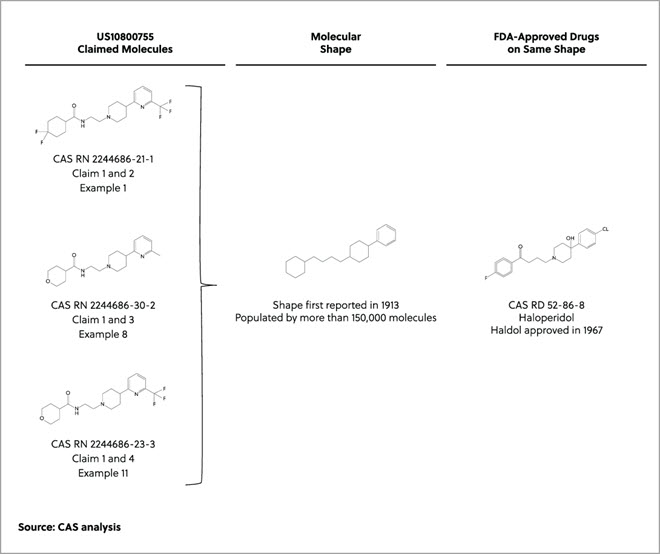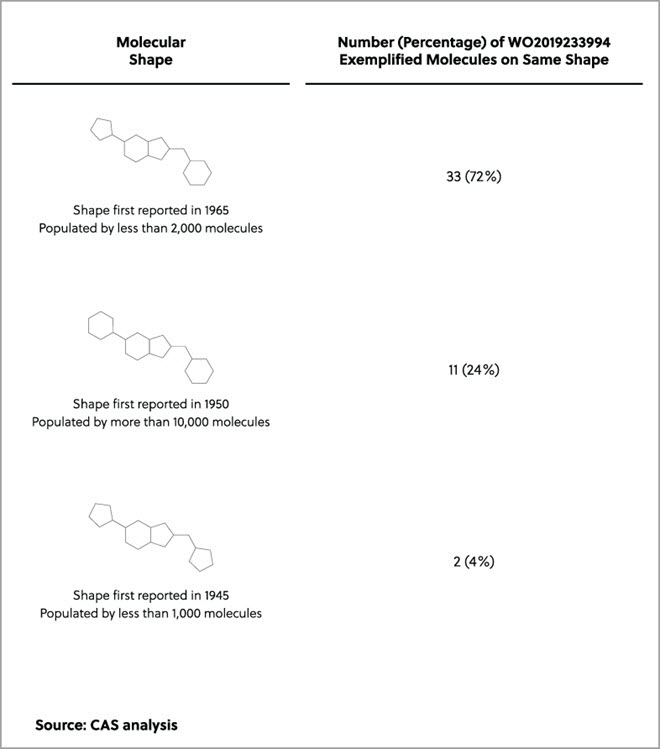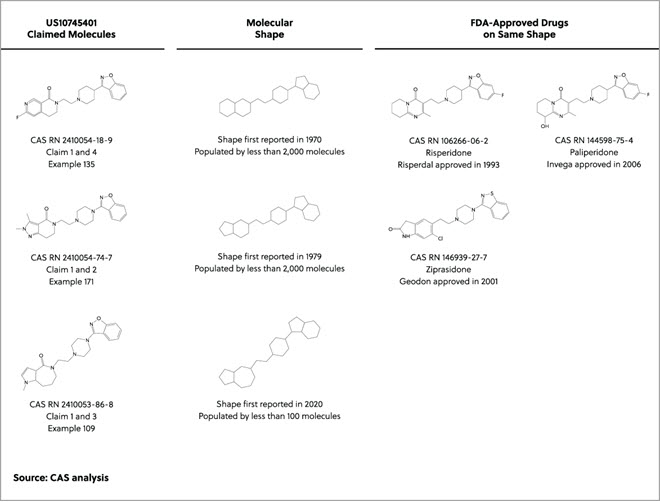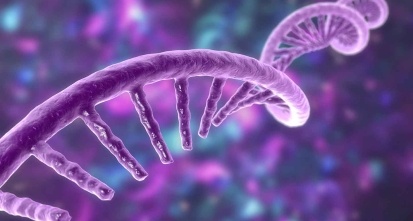Gain new perspectives for faster progress directly to your inbox.

AI-driven discovery continues to gain momentum and achieve critical milestones, including drug discovery.The first AI-designed drug candidate to enter clinical trials was reported by Exscientia in early 2020, a pivotal moment in AI drug discovery. Since then, several companies, including Insilico Medicine, Evotec, and Schrödinger have announced phase I trials. Several candidates have had their clinical development accelerated through AI-enabled solutions. Within drug-companies focused on AI-based discovery there is publicly available information on about 160 discovery programs, of which 15 products are reportedly in clinical development.
As structurally novel molecules are significantly more likely to be the source of promising new therapies, it’s essential to consider ways to measure the novelty of AI-designed molecules. CAS published a new indicator of drug innovation based on the structural novelty of new molecular entities (NMEs) to better assess the innovativeness of new AI drugs.
We used this new measure of early-stage AI drug discovery to evaluate the structural novelty of the first three AI-designed drug candidates to go into human clinical trials. All three molecules (DSP-1181, EXS21546, and DSP-0038) are in Phase 1 trials and were discovered using Exscientia’s AI platform. Even though the exact structures were not disclosed, details contained in recent patent filings and Exscientia’s IPO prospectus help us focus our analysis on specific molecules of interest.
How ground-breaking are the first three AIdrug candidates? Here’s what our analysis found:
DSP-1181 in AI drug discovery
The initiation of a Phase 1 clinical study in Japan of DSP-1181 was announced in January 2020. DSP-1181 is a full serotonin 5-HT1a receptor agonist discovered as part of a collaboration between Exscientia and Sumitomo Dainippon Pharma. It is currently being investigated as a treatment for obsessive-compulsive disorder (OCD).
Only three drug molecules are specifically claimed in US10800755 (one of the two granted patents in the DSP-1181 family of patents). Our structural analysis revealed that all claimed molecules (Examples 1, 8, and 11) share their shape with haloperidol, a frequently used first-generation (typical) antipsychotic agent, which the FDA approved in 1967 (see the table below). Even though they are not FDA-approved for treating OCD, some antipsychotics, such as haloperidol, have been used with some success in augmenting selective serotonin reuptake inhibitors (SSRIs) in patients with OCD.

The patent also contains 38 exemplified molecules with disclosed bioactivity data, which according to Exscientia’s prospectus, represent 11 percent of the 350 molecules that were synthesized and assayed during the discovery of DSP-1181. The shapes of these exemplified drug molecules lack structural diversity, as 58 percent of the exemplified molecules share the same shape as haloperidol, the FDA-approved drug highlighted in the table above. An additional 21 percent of the exemplified molecules are concentrated on a shape shared by 28 other FDA-approved drugs, including lamotrigine, an antiepileptic drug and mood stabilizer that has been occasionally used in OCD treatment. The remaining eight exemplified drug molecules are spread across three other shapes.
EXS21546 in AI drug discovery
In December 2020, Exscientia’s most advanced, internal lead drug candidate, EXS21546, began a Phase 1 clinical trial in the United Kingdom as an immuno-oncology treatment for several types of tumors. EXS21546 is an adenosine A2a receptor antagonist discovered as part of a collaboration between Exscientia and Evotec.
Its patent, WO2019233994, contains 46 exemplified molecules with disclosed bioactivity data, which according to Exscientia’s prospectus, represent 28 percent of the 163 molecules that were synthesized and assayed during the drug discovery of EXS21546. The exemplified molecules reflect three structurally similar shapes, as the size of only a few of their rings differs by one or two atoms (see the table below). Even though these shapes are not currently shared with any FDA-approved drugs, our analysis revealed that they are shared with other reported A2a antagonists, including several identified by Janssen and disclosed in WO2010045006, WO2010045013, and WO2010045017 (all patents filed in the late 2000s).

DSP-0038 in AI drug discovery
The initiation of a Phase 1 clinical study in the United States of DSP-0038 was announced in May 2021. DSP-0038 is a dual-targeted 5-HT1a receptor agonist and 5-HT2a receptor antagonist discovered as part of a collaboration between Exscientia and Sumitomo Dainippon Pharma. It is currently being investigated as a treatment for Alzheimer’s disease psychosis.
Only three molecules are specifically claimed in US10745401 (currently the only granted patent in the DSP-0038 family of patents). The shapes of the claimed molecules (Examples 109, 135, and 171) are structurally similar, as the size of only a few of their rings differs by one or two atoms (see the table below). Our analysis of the clinical trial data found two of the claimed molecules (Examples 135 and 171) share their shape with previously FDA-approved atypical antipsychotics used to treat a variety of psychiatric conditions. The remaining shape is not currently shared with any FDA-approved drugs, but it is structurally similar to the shape of several serotonin receptor agonists/antagonists identified by Yoshitomi Pharma and Suntory and disclosed in US5141930 and US6258805 (both patents filed in the 1990s). Their linker lengths only differ by a few atoms from the shape of Example 109.

The patent also contains 194 exemplified drug molecules with disclosed bioactivity data, which, according to Exscientia’s prospectus, represent almost 40 percent of the 500 molecules that were synthesized and assayed during the discovery of DSP-0038. The shapes of these exemplified molecules lack structural diversity, as 78 percent of the exemplified molecules share the same shape as the FDA-approved drugs highlighted in the table above and 93 percent of the exemplified molecules are concentrated on the shapes of the three claimed molecules. The remaining 14 exemplified molecules are spread across eight other shapes.
Final thoughts on AI drug discovery
The structural innovativeness of these candidates in AI drug discovery might not set the world on fire, but this does not diminish the potential impact AI will have on drug discovery. Rather than holding AI to a perfect standard, the novelty of AI drug molecules should be judged by the same standards as molecules designed by medicinal chemists. In this case, medicinal chemists more than likely would have identified these molecules as potential drug candidates using traditional approaches based on existing scientific literature.
As the futurist Roy Amara famously said, “We tend to overestimate the effect of a technology in the short run and underestimate the effect in the long run.” Amara’s point is extremely relevant in this case. New technologies such as AI drug discovery will be initially overhyped, but given time, may significantly change the world.
The clinical advantages more often associated with structurally novel drugs highlight the importance of pushing the boundaries of chemical space even further in the search for new drugs.Measuring innovation within the pharmaceutical industry is challenging, but CAS have managed to show how pharmaceutical innovation has significantly increased over the last several decades; see our ACS publication on how structural novelty has been proposed and used to analyze recent trends in pharmaceutical innovation.



